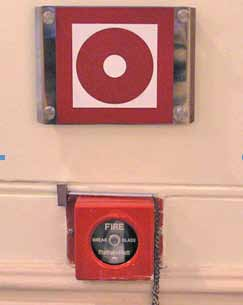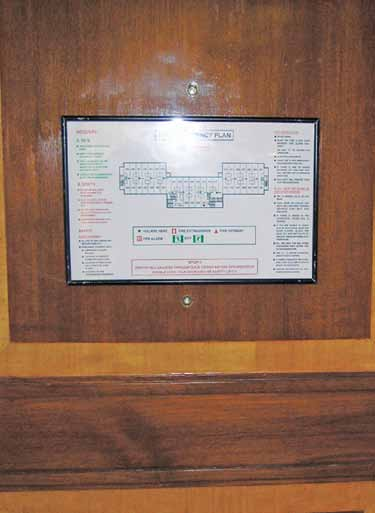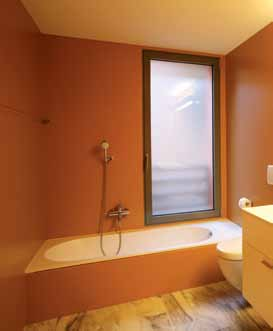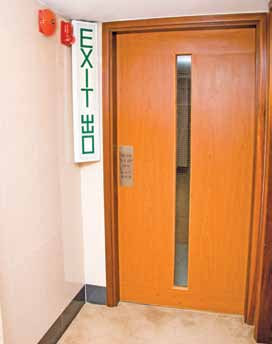 When planning Accessible Emergency Egress procedures, it is important to include needs of persons with disabilities. Accessibility is not only about providing independent ingress and usage of the hotel premises but also ensuring safe egress for persons with disabilities. The following text explains the important aspects of emergency and evacuation, which need to be considered for persons with disability.
When planning Accessible Emergency Egress procedures, it is important to include needs of persons with disabilities. Accessibility is not only about providing independent ingress and usage of the hotel premises but also ensuring safe egress for persons with disabilities. The following text explains the important aspects of emergency and evacuation, which need to be considered for persons with disability.
Raising the Alarm
- Placement (accessibility) and visibility of such devices is very important. The following is to be considered for the installation of such alarm devices;
- Fire alarm boxes, emergency call buttons and lit panels should be installed between heights of 800mm and 1000mm from the furnished floor surface. These should be adequately contrasted from the background wall and should be labelled with raised letters and should also be in Braille.
- A pre-recorded message, alerting an emergency to the control room or reception should be installed in the room telephone in the accessible bedroom and this should be accessible by a ‘hotkey’ on the phone keypad. This ‘hotkey’ should be distinct from the rest of the keypad.
Alerting Systems
In emergency situations, it is critical that people are quickly alerted to the situation at hand, for persons with disability the
following needs to be considered.
- Consider having audible alarms with ‘voice instructions’ that can help guide them to the nearest emergency exit.As an alternative to the pre-recorded messages, these alarms may be connected to the central control room for on-the-spot broadcasts.
- Non-auditory alarms (visual or sensory) to alert persons with hearing impairments should be installed at visible locations in all areas that the guest may use (including toilet areas, etc.).
Non-auditory alarms include:
- Flashing beacons
- Vibrating pillows and vibrating beds.
- Pagers or mobile phones that give out a vibrating alarm along with a flashing light (these may be issued to persons with vision or hearing impairments at the time of check-in to the hotel.)
 Written Evacuation Procedure
Written Evacuation Procedure
A written evacuation procedure that details the egress plan for disabled guests should be installed behind the entrance door in the accessible guest rooms and also in other facilities that the guest may visit e.g. changing rooms in the health club. The evacuation procedure should be detailed in large print letters that contrast strongly against the background. Where possible, it should also incorporate raised letters and Braille. The evacuation route should be displayed on a high contrast tactile map for the benefit of persons with vision impairments.
Emergency Evacuation Route
- Designate routes that are at least 1200mm wide, to ensure a wheelchair user and an able bodied person are able to pass each other along the route. The route should be free of any steps or sudden changes in the level and should be kept free from obstacles such as ash trays and flower pots.
- Use appropriate signage along the route. Orientation and direction signs should be installed frequently along the evacuation route and these should preferably be internally illuminated. The exit door signage should also be internally illuminated.
- A ‘way guidance lighting system’ consisting of low mounted LED strips to outline the exit route (with frequent illuminated direction indicators along the route) should be installed along the entire length of the evacuation route. This is to supplement the overhead emergency lighting units, conforming to the Indian Standard IS: 9583-1981, that are recommended by the “Delhi Fire Prevention and Fire Safety Act, 1986” and “Delhi Fire Prevention and Fire Safety Rules, 1987”.
Research indicates that way guidance systems allow people with vision impairments to walk significantly faster than traditional overhead emergency lighting and/ or normal overhead lighting. Moreover, emergency exit lights and directional signals mounted near the floor have been found to be useful for all people in cases where a lot of smoke is present.
Considerations when installing the way guidance system:
- Minimum luminance on the floor should be at least 1 lux along the centre line of the route and on stairs.
- Install clear illuminated sign above exit and also directional signage along the route.
- The directional exit signs with arrows indicating the way to the escape route should be provided at a height of 500mm from the floor level on the wall and should be internally illuminated by electric light connected to corridor circuits.
- Signs should be large enough to be recognised from a distance, and symbols and legend on signs should be at least 150mm in height and arrows should be minimally 35mm in height for the signs to be understood at a distance of 1 metre.
- Escape route lighting should be as simple and clear as possible, and wall markings as continuous as possible.
- It is preferable to have LED tracks on both sides of the corridor to outline the escape route and also give an idea of width of the corridor. LED strips should also be installed on the nosings of stairs in the evacuation route.
 Refuge Area
Refuge Area
It is strongly recommended that a refuge area be provided at least on the floors that accommodate the accessible guest rooms and other common facilities, such as the health club. A refuge area should:
- Have appropriate signage, preferably with internal illumination.
- Have a two way communication system for disabled people to be able to communicate with the central control room. The communication system should be installed between the heights of 800mm and 1000mm from the furnished floor surface.
- Have assistive evacuation equipment such as evacuation chairs and stretchers.
Fireproof Evacuation Lift/ Elevator
In the event of an emergency, a fireproof evacuation elevator that works safely in the event of a fire can prove to be a life saving provision for persons with mobility impairments. These lifts also enable fire-fighters and hotel staff, who may be manually screening the premises to rescue unconscious guests, to get to other floors quickly.
Doors
Fireproof doors generally require a force greater than 25 Newtons to operate, rendering several disabled people dependent on others to negotiate these doors. While it is essential to cater safety measures for unpredictable emergencies, it is also important to provide an accessible environment to disabled guests. Consider holding the doors open with magnetic catches or ‘floor springs’ that are connected with the fire alarm system.
 Summary
Summary
- Alarm switches should contrast visually from the background wall and be installed between heights of 800mm and 1000mm from the floor level.
- Emergency alarms should have a visual and audible output.
- Consider installing non-auditory alarms such as flashing beacons, vibrating pillows or issuing vibrating pagers that are lined with the emergency alarm to guests at the time of checking into the hotel.
- An evacuation plan, detailing the evacuation procedure for disabled guests, should be installed in accessible guest rooms and at all other facilities that the guest may visit. This plan should be in large print format with the evacuation route represented in the form of a tactile map.
- Emergency evacuation routes for disabled guests should offer a step free and unobstructed path that is at least 1200mm wide.
- A ‘way-guidance lighting system’ should outline the entire length of the exit route.
- Internally illuminated directional signage should be installed at regular intervals along the evacuation route.
- Provide refuge areas that can accommodate at least two wheelchair users simultaneously on all floors above the ground level. Refuge areas should be equipped with an ‘evacuation chair’ and a two-way communication system that is linked with the central control room.
- Consider installing a fire proof evacuation elevator.
YOU MAY ALSO LIKE…
- Hotel Accessibility Manual – Accessible Parking
- Hotel Accessibility Manual – Main Entrance
- Hotel Accessibility Manual – Corridors
- Hotel Accessibility Manual – Ramps & Handrails
- Color and Luminance Contrast – Hotel Accessibility Manual
- Accessibility Business Centre and Conference – Hotel Accessibility Manual
- Accessiable Restaurant, Bar, Pub and Lounge – Hotel Accessibility Manual
- Pool Accessibility, Spa Accessibility and Health Club Accessibility
- Accessible Public Restroom Design
- Accessible Guest Rooms
- Accessible Exterior surfaces and Interior Doors
- Accessible Floor Plans
- Signage
- Accessible Lighting
- Accessible Bathroom and Shower Room
Ref : Universal Design India Principles – ITC Hotels